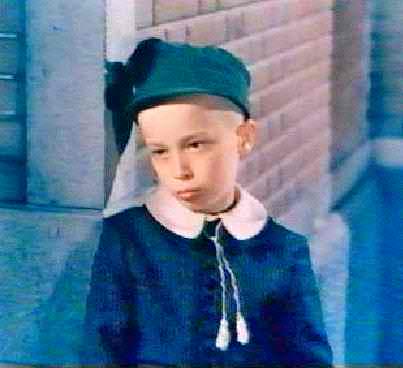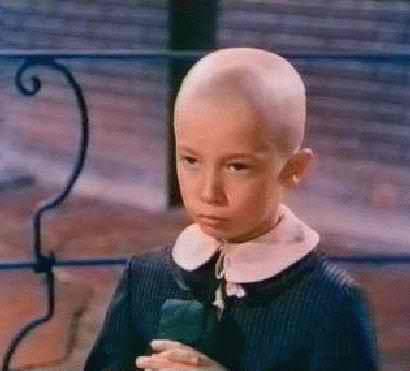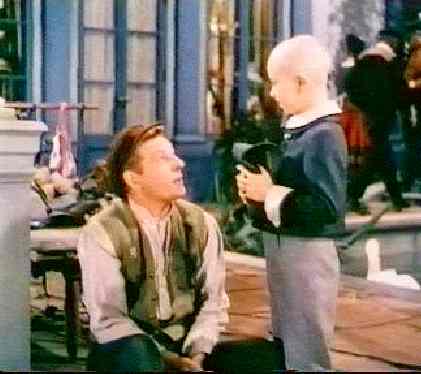
Figure 1.--This boy in the movie has a shaved head. He was embarassed about it and tried to cover it up with his cap.


Figure 1.--This boy in the movie has a shaved head. He was embarassed about it and tried to cover it up with his cap. |
The Danny Kaye movie in 1952 was a big budget Hollywood production detailing the life of the famed Danish story teller. I'm not sure about the accuracy of the costuming.
Hans Christian Anderson was born on April 2, 1805, and his early life was full of great sadness. His family was very poor. He was the only son of a poor cobler and his wife. His father died when he was 11 years old. It was Hans' father, a self-taught student and free thinker, who got Hans' creative juices flowing by telling him stories and teaching him how to build and work a puppet theater as a young boy. His father would read him a story every day at 2:00. But Hans' childhood was not a happy one. His
father died when only in his early thirties, and Hans, at age eleven, was left with his mother, a rough, hard working, illiterate peasant woman. When Hans was 14 he ran away to Copenhagen. He could hardly attend school.
At age fourteen Hans left Odense for the city of Copenhagen. He spent his time in and out of theaters and drawing-rooms, begging, cajoling and pleading for money
from patrons and even from the king. Eventually his guardians made him attend school and acquire the formal education he was lacking. In 1822 he went to the Latinschool in Slagelse. When he had finished he was allowed to chose a profession. He choice was to write.
Anderson was Denmark's most famous author. Anderson wrote as many as 350 stories. His books are read all over the world. Here are 5 of the many stories
hewrote: The Ugly Duckling, The Emperor's New Cloths, The Little Mermaid, Thumbelina, and The Red Shoes. One of his most interesting book's is The Emperor's New Clothes. It is about a king who is very vain,and two people teach him a lesson. Anderson always wanted new things, but he could not buy them. This story is a reflection of his life.

Figure 2.--The other children tease the boy about his bald head making him very sad. |
All of the stories Anderson wrote were with a great desire to make people laugh. He also wrote because he didn't want children to have a sad childhood as he did.
He also wanted to fill little girls and little boys hearts full of joy and laughter. He always wrote with a sly humor. Through his writings, Anderson felt more self fulfilled.
More than acentury after his death, Hans Christian Anderson is still fondly remembered today. Hans Anderson died on August 4, 1875. Denmark's people always celebrate his birthday
with a party called "Odin Story Day". The Anderson home in Odense is now a museum, and thousand of people visit it every year. After he died people read his stories and loved them just like when he was alive.
The star of the movie was of course, Danny Kaye. David Daniel Kaminski ("Danny Kaye"), was born 18 January 1913, in Brooklyn, New York, and died 3 March 1987, Los Angeles, California. For those of you unfamiliar with this film legend, he was a child actor of minor note. He came into his own with the musical comedies in the 1940s and 50s. He was also one of the original sponsors and spokespersons of UNICEF, when it was just starting out its mission of help for the world's hungry. He was what the film and stage world calls a "triple threat"- he could dance, sing,
and act equally well, and with a style and panache all his own. And not only that, but he was hilariously funny! By far one of the best single comedians ever to
grace the silver screen.

Figure 3.--Danny Kaye was the star of this lavish Hollywood musical. Here he tries to cheer the boy up, sing the story of the Ugly Ducling. |
The story line is of course the life of Hand Christian Amderson. It beginsm if I remember correctlty, with Hans running away from home. There is no child actor to play him as a young boy. The boy pictured here is being mocked by his fellow pupils because of his shaved head. I seem to recall that it been shaved because of a medical condition. He tries
to keep his head covered but to his shame and embarrassment the other shoolchildren knock his hat off, revealing the shorn pate. Newly arrived in Wonderful Copenghagen, Hans Andersen has already developed his gift of amusing and instructing both young and old with his stories and songs. He takes the poor lad aside and sings to him The Ugly Duckling, telling of how the plain little duckling eventually becomes a swan.
The musical includes such classics as....Anywhere I Wander; The Ugly Duckling; Inchworm; No Two People; Uncle Pockets...and more. Music and lyrics for all the songs are by the great Frank Loesser of Guys and Dolls fame. (Incidentally, a perhaps apocryphal tale is told of Frank's wife. She was considered rather disagreeable and was known as 'the evil of two Loessers'.)
An HBC contributor reports, "I saw the film as a child and always loved the songs. They were often played on Childrens' Choice on BBC radio in the 1950s and 60s. By the way, I don't remember the song Uncle Pockets in the movie."
HBC has no information on the accuracy of the Hollywood costuming in this film.
Navigate the Boys' Historical Clothing Danish pages:
[Return to the Main Danish page page]
[Danish choirs]
[Danish youth movements]
[Danish royalty]
[Danish sailor suits]
Navigate the Boys' Historical Clothing related style pages:
[Return to the Main Movie page]
[Lederhosen]
[Peter Pan collar]
[Shaved heads]
[Skeleton suits]
[Ethnic]
[Tights]
[Long stockings]
Navigate the Boys' Historical Clothing Web Site:
[Introduction]
[Activities]
[Bibliographies]
[Biographies]
[Chronology]
[Clothing styles]
[Contributions]
[Countries]
[Boys' Clothing Home]
